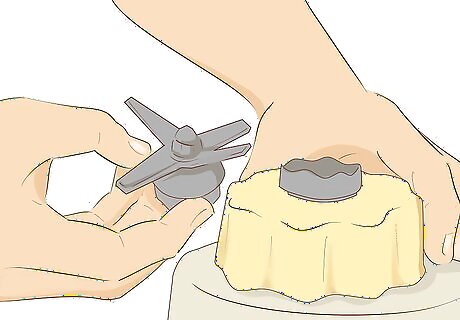
views
Using Your Blender Correctly

Assemble the blender properly. Secure all the parts each time you use it, and follow any instructions given in the blender's user manual regarding proper assembly. Make sure that the blade is securely tightened in the blender's base, and that the glass or plastic container (also called the carafe) unit is firmly seated in the motorized base unit. In most cases, an incorrectly assembled blender just won't work or won't work well, but sometimes, loose parts could fly out or you could damage the blender.

Blend only appropriate items. Blenders are designed to chop up soft food items and liquids, and should be used only for this purpose. If you're using your blender to grind up or chop hard foods, you'd be better off using a food processor. If you do use a blender for making paper or some other non-food purpose, be aware that it may permanently damage the blender. Use a separate, inexpensive blender that you won't mind losing.

Cut up larger pieces of food. If you're blending large food items, like big chunks of pineapple, watermelon, or citrus fruits, be sure to cut these into smaller pieces before blending. You can cut things in fairly large chunks; aim for about 2 square inches (13 square centimeters). Smaller chunks will blend more easily and much quicker than uncut fruit. Make sure the pieces of food you're blending are at least small enough to fit into the bottom part of your blender.

Add plenty of liquid to the mix that you're blending. A mixture that is too dry will behave like a paste and push up away from the blades. This is not necessarily harmful, but it's not too effective, either. Depending on what foods you're blending, you may add different liquids: water, milk, fruit juice, soup stock, and so on. Add a little liquid at a time, then blend and see if the consistency has improved. If you add to much liquid at once, your smoothie could quickly become a thin soup.
Cleaning Your Blender

Clean your carafe after each use. Simply pour couple of cups of water and a few drops of dish soap into the carafe. Then run it on "pulse" for about 30 seconds. If the sides and bottom of the blender are clean after this, pour out the soapy water and rinse the carafe. Be careful not to get any water in the motorized base unit of the blender during the cleaning process.

Clean with lemon to remove stubborn stains. If your carafe still looks scummy or streaky after you've cleaned it with soap, you can use a lemon to efficiently clean it. Coarsely chop up a full lemon, and drop this into the blender along with a few drops of dishwashing soap. Fill the blender halfway with warm water, and run for about a minute. Dispose of the lemon. These dirty streak marks on the inside of the carafe are often left by minerals found in hard water.

Clean the blender thoroughly each month. Unscrew the blade assembly and pull out the blender blades, gaskets, and other components. Wash these by hand using warm water and a soft rag or sponge. Wipe with a soft cloth after cleaning, taking care not to touch the blades. Make sure the blender has ample time to dry, and reassemble the blender with the rubber gasket or seal on the correct side of the blade assembly. You don't have to do this every time you use the blender. If you use the blender daily or almost daily, give the blender a thorough cleaning monthly.
Troubleshooting Common Issues

Unblock jammed blades. If the blades do not rotate, make sure it is plugged in and that the outlet has power. If the blades of your blender aren’t correctly rotating, even with the motor running, unplug the unit immediately. Unscrew the base from the carafe, pull off the gasket, and then carefully remove the blade from its housing in the carafe. Inspect around its base (and around the cutter shaft) for any built-up food residue. If the blades still do not turn, it's probably either the switch or the motor. If the cutter shaft sticks, remove the jug, turn it upside down, and spray a lubricant (like WD-40) over the blades.

Replace worn, bent, or dulled blades. Once they're worn out, the blades of a blender cannot be sharpened. To find replacement blades, either contact the manufacturer and ask about replacement parts, or look for replacement parts on the manufacturer’s website.

Fix a leaking blender. If you notice liquid leaking out from around the bottom of the carafe unit, there is most likely a small gap between the base of the blender unit and the carafe. Pour the liquid out of the blender, and unscrew the base unit. Make sure that the gasket is firmly in place and not worn or cracked. Then, put the blender firmly back together. Check under the carafe unit periodically to make sure that the little tabs at the base are all intact. If one or more are broken then you will need to replace the carafe. Replace a broken or cracked pitcher. Most manufacturers offer replacements for sale.

Replace a broken switch. If your blender is unresponsive when you flip its on/off switch, or if it doesn't properly respond when you change speed settings, you may need to replace the switch. Follow the instructions in the owner's manual that describe how to remove and replace the unit's switch. If you do not already have a replacement switch, contact the manufacturer and ask them to send you a replacement switch. Or ask the manufacturer to suggest a store to purchase a switch from.

Take your blender in to an appliance repair shop. Some problems with your blender will need to be handled by a professional. For example, if you have difficulty selecting different speeds, refer to your manual to make sure you are doing it right. Otherwise, take the blender to an appliance repair shop and ask to have the speed control switch serviced.




















Comments
0 comment